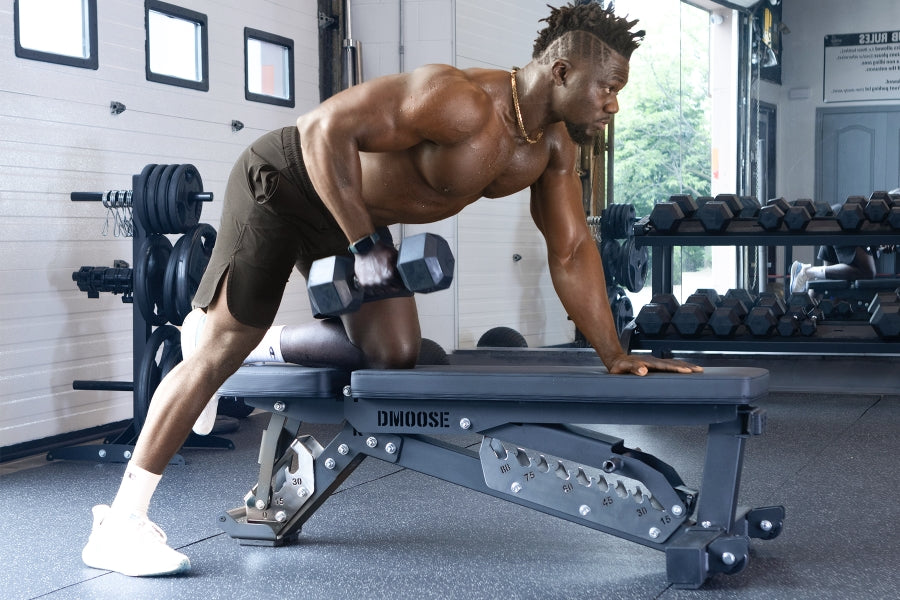Many people invest in a weight bench with big goals in mind. But they end up repeating the same basic moves, seeing little progress, and wondering what they’re doing wrong.
It’s frustrating when the results don’t match the effort. But here’s the good news: your bench holds far more potential than you think.
With the right exercises, it can become the foundation for a powerful full-body workout. You can also pair these exercises with an Adjustable Dumbbell Set to unlock even more variety and resistance options.
In this blog, you’ll discover 15 dynamic bench exercises that will reignite your motivation, challenge your entire body, and help you train smarter, not harder.
15 Weight Bench Exercises You Need for a Complete Full-Body Workout
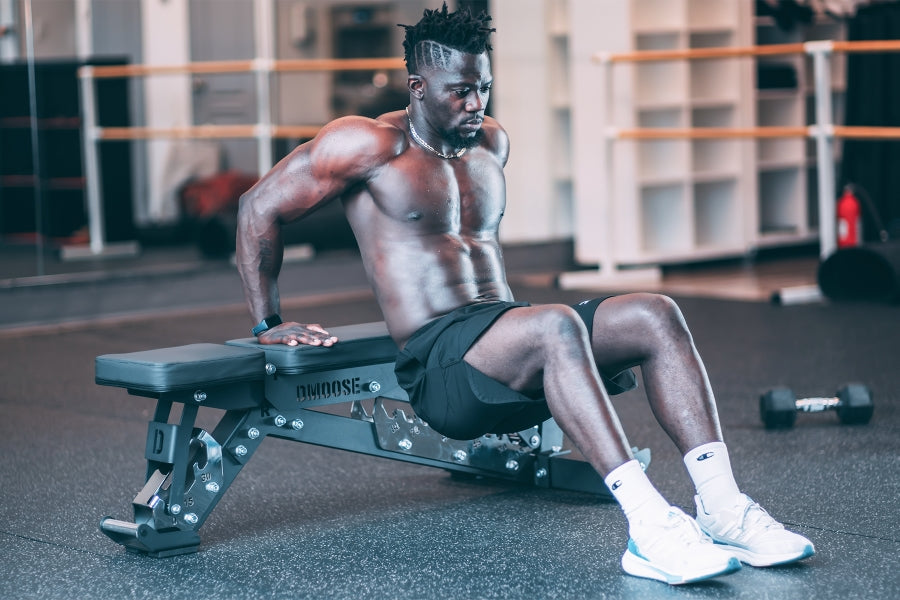
Stop limiting your bench to just a few upper-body moves. These exercises are designed to maximize every rep, giving you a total-body transformation with just one piece of equipment.
1. Dumbbell Bench Press

The dumbbell bench press is one of the most effective upper-body exercises for developing chest, shoulder, and triceps strength. Unlike a barbell press, it allows for a greater range of motion, which activates more muscle fibers and enhances muscular balance.
This movement is essential for building foundational pushing strength and can be adapted based on your fitness level or equipment preference. Whether you're using dumbbells or a barbell, it's a staple for anyone looking to add size and definition to their upper body.
How to Perform Dumbbell Bench Press
- Sit on the bench with a dumbbell in each hand, resting them on your thighs.
- Lie back and bring the dumbbells to your sides at chest level with palms facing forward.
- Press the dumbbells upward until your arms are fully extended over your chest.
- Pause briefly at the top and squeeze your chest muscles.
- Lower the dumbbells slowly to the starting position, maintaining control.
- Repeat for the desired number of reps.
2. Incline Dumbbell Bench Press
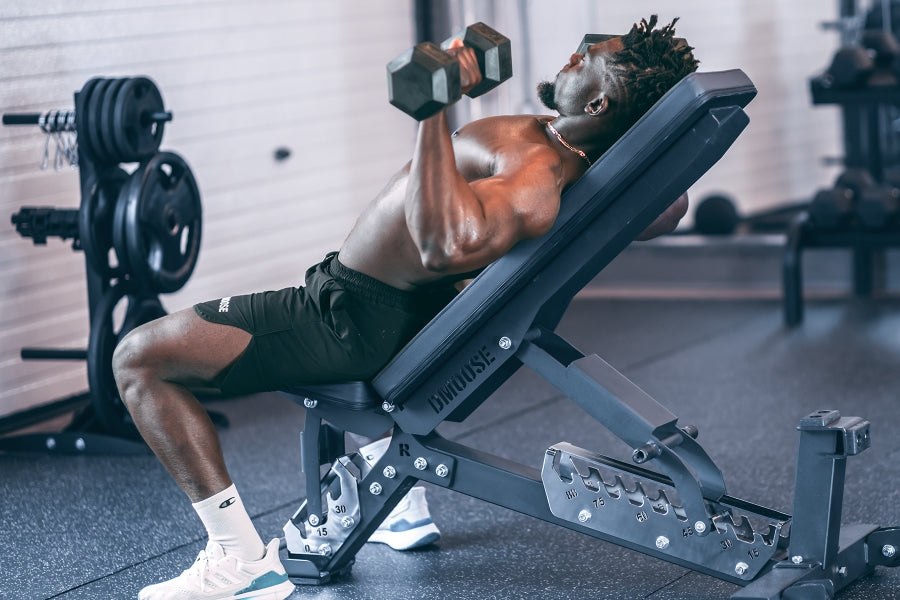
The incline dumbbell bench press is a powerful variation that emphasizes the upper portion of the chest. By setting the bench at an incline, you shift the focus to the clavicular head of the pectoralis major, helping to develop a fuller, more defined chest.
This movement also engages the shoulders and triceps, making it ideal for correcting muscle imbalances and improving overall upper-body symmetry. Suitable for all fitness levels, it's a valuable addition to any strength-training program.
How to Perform Incline Dumbbell Bench Press
- Set your bench at an incline angle of 30 to 45 degrees.
- Hold a dumbbell in each hand, resting them on your thighs.
- Lie back and position the dumbbells at chest level with your palms facing forward.
- Press the dumbbells upward until your arms are fully extended above your chest.
- Pause briefly at the top, then lower the weights in a controlled motion.
- Repeat for the desired number of repetitions.
3. Decline Dumbbell Bench Press
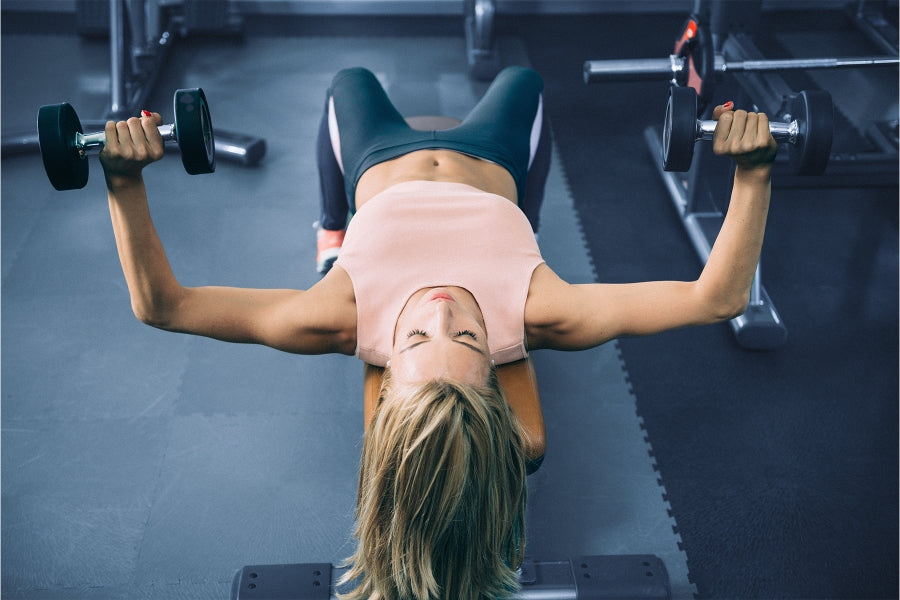
The decline dumbbell bench press is a powerful variation that targets the lower portion of the chest—an area often undertrained with traditional presses. By angling the bench downward, you shift the focus to the lower pectoral fibers, improving overall chest development.
This variation also challenges your core and stabilizer muscles as you maintain control on the decline. Incorporating it into your routine adds variety and can prevent plateaus by stimulating muscle growth from different angles.
How to Perform Decline Dumbbell Bench Press
- Set the bench to a decline position and secure your legs under the support pads.
- Hold a dumbbell in each hand and lie back with the weights near your chest.
- Position your palms facing forward and press the dumbbells upward until your arms are fully extended.
- Pause briefly at the top of the movement.
- Lower the dumbbells slowly back to the starting position under control.
- Repeat for the desired number of reps.
4. Dumbbell Flyes
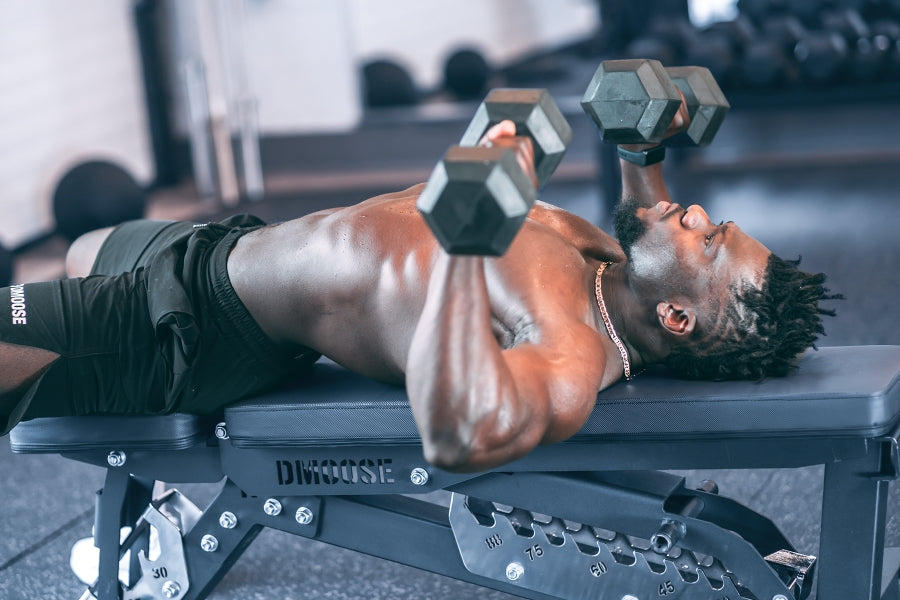
Dumbbell flyes are an isolation exercise that emphasizes chest expansion through a wide range of motion, making them ideal for targeting the inner chest. Unlike pressing movements, flyes use arm adduction to deeply engage the pectoral muscles and enhance muscle definition.
They also promote flexibility, improve posture, and can help reduce upper body stiffness or back discomfort. This movement is excellent for enhancing mind-muscle connection and developing a well-rounded chest.
How to Perform Dumbbell Flyes
- Lie flat on a bench while holding a dumbbell in each hand above your chest.
- Keep a slight bend in your elbows to reduce joint strain.
- Slowly lower the dumbbells outward in a wide arc until your chest feels fully stretched.
- Bring the weights back up using the same arc, squeezing your chest at the top.
- Maintain control throughout and repeat for the desired number of reps.
5. Paused Bench Press
The paused bench press is a variation that introduces a deliberate pause at the bottom of the lift, forcing your muscles to overcome inertia without relying on momentum. This brief hold significantly increases time under tension, helping build raw pressing strength and better technique.
By pausing, you improve control and reinforce stability at the weakest point of the lift. Over time, this enhances muscle coordination, body awareness, and overall bench press performance.
How to Perform Paused Bench Press
- Lie flat on the bench with your feet firmly planted on the floor.
- Grip the barbell slightly wider than shoulder-width apart.
- Unrack the bar and hold it above your chest with arms fully extended.
- Lower the barbell slowly until it touches your chest.
- Pause for about three seconds while maintaining control.
- Press the bar upward by extending your arms back to the starting position.
6. Dumbbell Preacher Curls
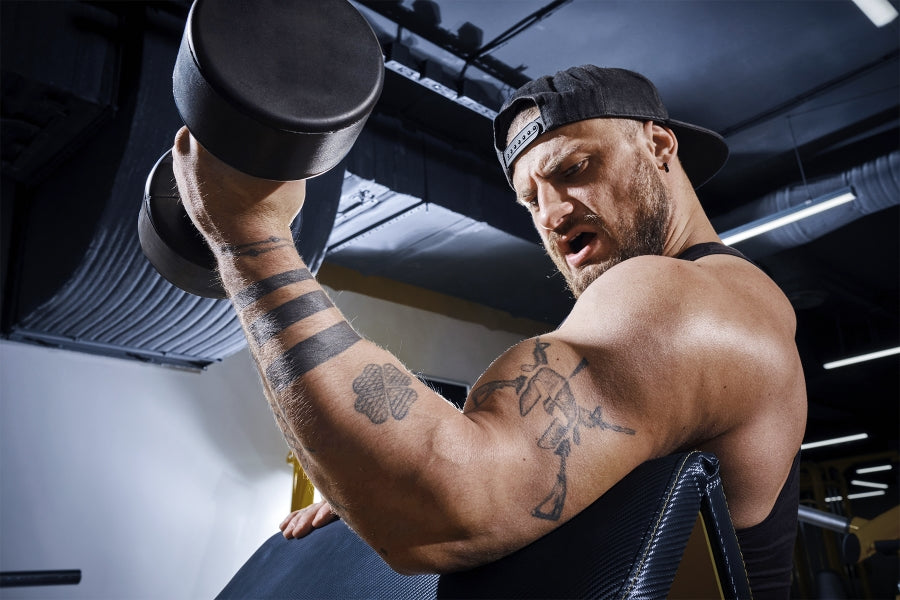
Dumbbell preacher curls are a highly focused isolation exercise that targets the biceps, especially the long head responsible for developing the bicep peak. The preacher bench helps eliminate momentum, forcing your muscles to do all the work and maximizing contraction.
This exercise allows you to train one arm at a time, which is ideal for correcting imbalances in strength and size. Its adjustable resistance makes it suitable for all fitness levels, from beginners to advanced lifters.
How to Perform Dumbbell Preacher Curls
- Sit at a preacher bench and grip a dumbbell with one hand.
- Place the upper part of your arm flat against the bench pad, with your elbow slightly bent.
- Lower the dumbbell slowly until your arm is almost fully extended.
- Curl the dumbbell back up to shoulder height by contracting your biceps.
- Maintain control throughout the movement.
- Repeat for the desired number of reps, then switch arms.
7. Dumbbell Skull Crushers
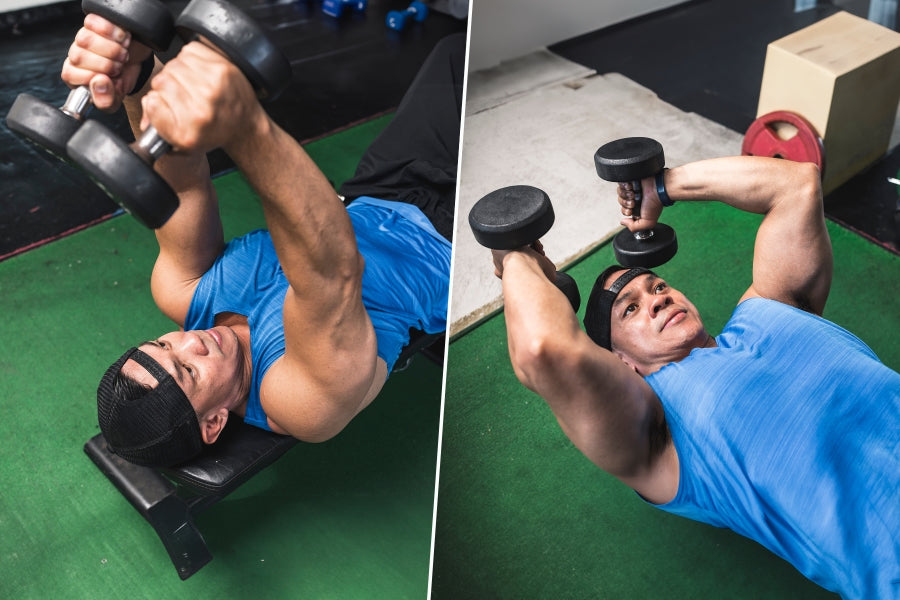
Dumbbell skull crushers are a powerful triceps isolation exercise that helps strengthen and tone the back of your upper arms. By directly targeting the triceps brachii, this movement enhances elbow extension and overall upper-body performance.
It’s an excellent addition to any strength training routine focused on arm development. Consistent practice improves arm definition, functional strength, and stability in pushing movements.
How to Perform Dumbbell Skull Crushers
- Sit on the edge of a bench holding a dumbbell in each hand.
- Lie back and raise the dumbbells above your shoulders with palms facing each other.
- Keep your upper arms stationary and bend your elbows to slowly lower the dumbbells beside your head.
- Pause briefly near the bottom for control and safety.
- Extend your arms to push the dumbbells back to the starting position.
- Repeat for the desired number of reps.
8. Dumbbell Tricep Kickbacks
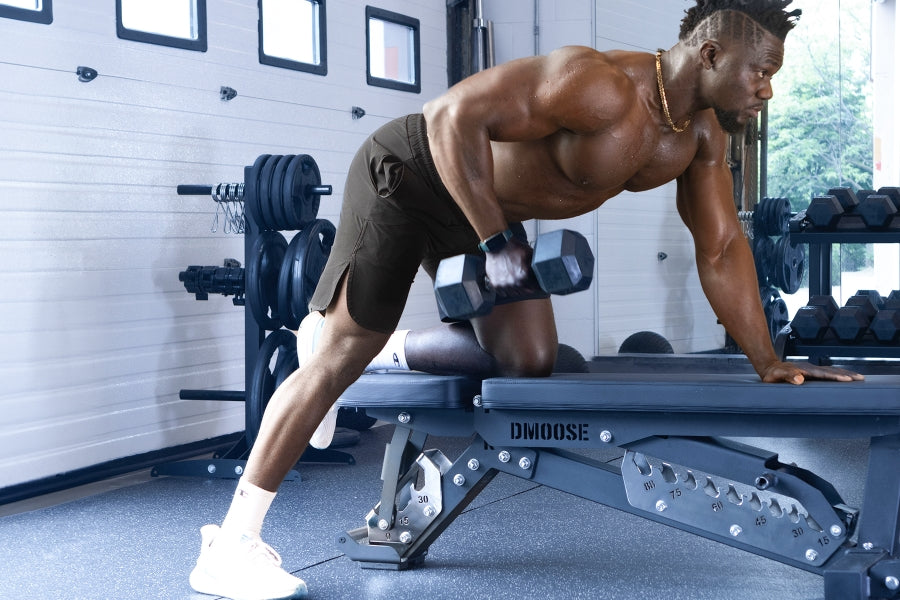
Dumbbell tricep kickbacks are an effective isolation exercise focused on developing the triceps—the muscles at the back of your upper arms. Strengthening these muscles not only improves the appearance of your arms but also supports pressing movements and functional strength.
This low-impact exercise enhances muscle tone while placing minimal stress on the joints. Whether you're aiming to sculpt your arms or boost upper-body strength, it’s a smart addition to any workout routine.
How to Perform Dumbbell Tricep Kickbacks
- Stand beside a bench and hold a dumbbell in one hand.
- Place your opposite knee and hand on the bench, leaning forward with a flat back.
- Bend the working arm so your upper arm is parallel to the floor and your elbow forms a 90-degree angle.
- Extend your arm fully backward by straightening the elbow.
- Pause briefly, then return to the starting position with control.
- Repeat all reps on one side before switching arms.
9. Close Grip Press
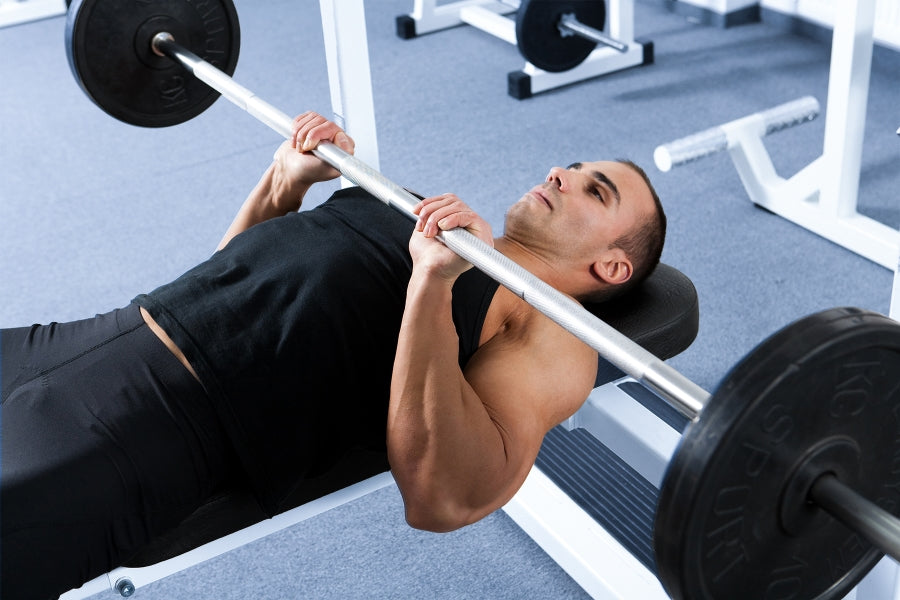
The close grip press is a variation of the traditional bench press, performed with a narrower hand placement to place greater emphasis on the triceps. This focused movement effectively targets all three heads of the triceps—long, medial, and lateral—making it ideal for building arm strength and size.
It also engages the chest and shoulders to a lesser degree, contributing to overall upper-body development. Whether you're looking to improve lockout strength or refine arm definition, this compound lift is a valuable addition to your routine.
How to Perform Close Grip Press
- Lie flat on a bench and grip the barbell with your hands about shoulder-width apart.
- Unrack the bar and hold it directly above your chest with arms extended.
- Inhale and lower the bar slowly toward your mid-chest, keeping your elbows close to your body.
- Pause briefly at the bottom of the movement for control.
- Exhale and press the bar back up to the starting position.
- Repeat for the desired number of reps.
10. Incline Bicep Curl
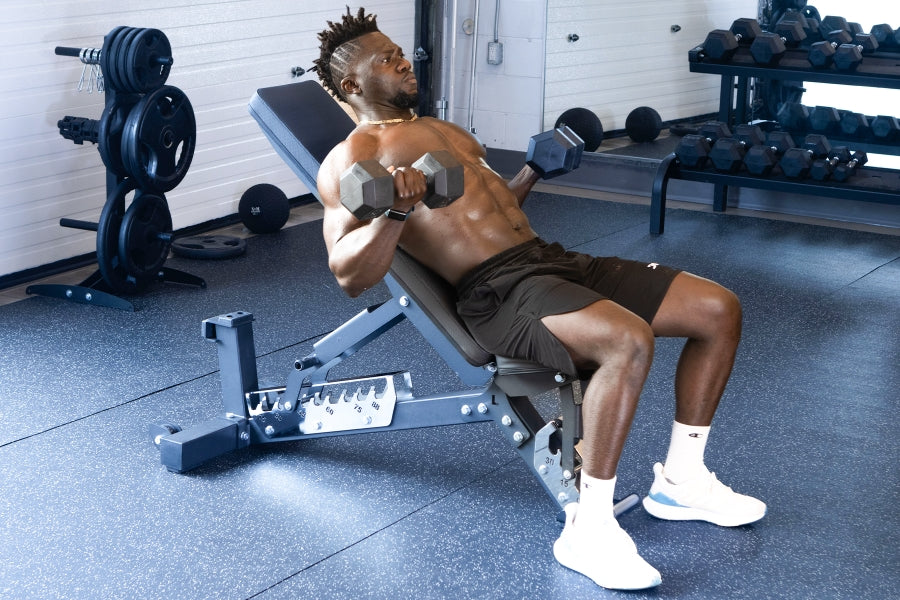
The incline bicep curl is a targeted isolation movement that places the biceps under greater stretch by minimizing shoulder involvement. This positioning helps recruit the long head of the biceps more effectively, leading to enhanced muscle growth and shape.
By focusing solely on the arms, this exercise contributes to better definition and muscle control, which can enhance performance in compound lifts and athletic activities. It’s an excellent choice for those aiming to sculpt their arms and improve upper-body aesthetics.
How to Perform Incline Bicep Curl
- Adjust a bench to a 45 to 60-degree incline and sit back with your spine supported.
- Hold a dumbbell in each hand with arms fully extended at your sides, palms facing forward.
- Keep your upper arms still and curl the dumbbells toward your shoulders.
- Squeeze your biceps at the top of the movement.
- Lower the dumbbells slowly and return to the starting position.
- Repeat for the desired number of reps.
11. Single-Arm Dumbbell Row

The single-arm dumbbell row is an effective unilateral exercise that targets the latissimus dorsi, helping to build a strong, symmetrical back. It allows you to train each side independently, correcting imbalances and enhancing overall muscle development.
Consistent practice improves posture, strengthens the mid and upper back, and supports spine health. It’s also excellent for building pulling strength that carries over into larger compound lifts.
How to Perform Single-Arm Dumbbell Row
- Stand beside a bench and place one knee and the same-side hand firmly on the bench.
- Keep your back flat and parallel to the floor, engaging your core for stability.
- Hold a dumbbell in the opposite hand with your arm fully extended toward the ground.
- Pull the dumbbell upward toward your torso by bending your elbow and squeezing your shoulder blade.
- Lower the dumbbell slowly back to the starting position with control.
- Complete all reps on one side, then switch arms.
12. Dumbbell Pullover
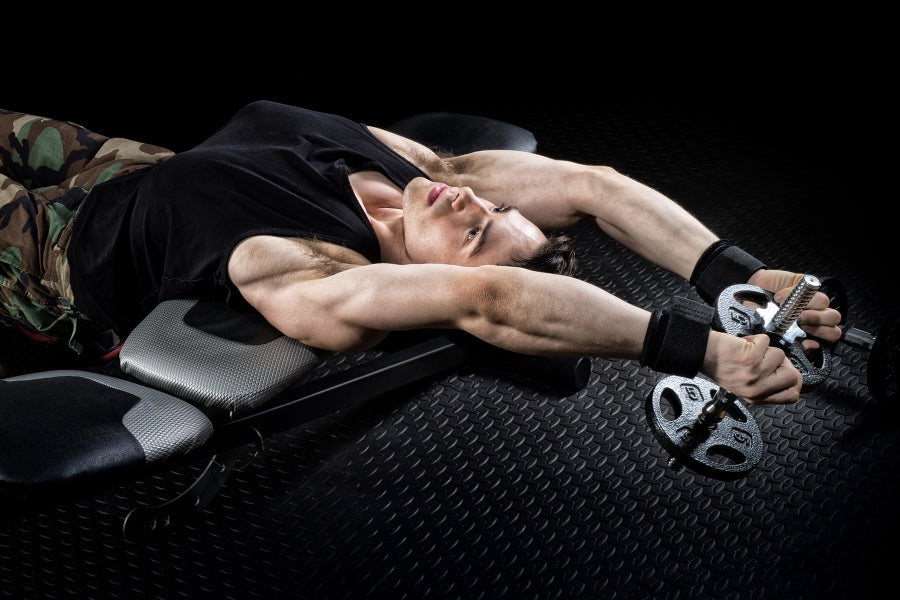
The dumbbell pullover is a versatile upper-body movement that primarily targets the latissimus dorsi and chest muscles. It’s a great addition to any program aiming to increase upper-body width and improve muscular control.
Incorporating this exercise regularly can contribute to a broader back and better posture. It also engages the core and shoulders, supporting overall stability and enhancing spine mobility.
How to Perform Dumbbell Pullover
- Lie on a flat bench with your upper back and shoulders supported, keeping your hips slightly lower than the bench.
- Hold one dumbbell with both hands above your chest, arms extended.
- Slowly lower the dumbbell in an arc over your head until your arms are roughly parallel to the floor.
- Keep your elbows slightly bent throughout the movement.
- Raise the dumbbell back to the starting position using the same arc.
- Repeat for the desired number of reps.
13. Chest Supported Scap Retractions
Chest supported scap retractions are an excellent isolation exercise for strengthening the upper back, specifically the rhomboids and trapezius muscles. This movement promotes muscular balance and helps develop a more symmetrical, well-aligned posture.
Regularly training the scapular muscles can reduce tension in the neck, improve shoulder stability, and support safer, more effective performance in compound lifts. It’s especially useful for anyone dealing with poor posture or upper-back weakness.
How to Perform Chest Supported Scap Retractions
- Set a bench at a 45-degree incline and lie face down on it, with your chest and torso supported.
- Hold a dumbbell in each hand with arms extended downward, palms facing each other.
- Keeping your arms straight, squeeze your shoulder blades together as if pinching a pencil between them.
- Hold the contraction for a few seconds at the top.
- Slowly release and return to the starting position.
- Repeat for the desired number of reps.
14. Seal Rows
Seal rows are a highly effective back isolation exercise that targets the rhomboids, trapezius, and rear deltoids. By eliminating momentum and lower-back involvement, this movement allows for strict form and deeper muscle engagement.
Because it’s performed lying flat on a bench, seal rows place minimal strain on the spine, making them a safe option for those recovering from lower back injuries or looking to avoid excess spinal loading.
How to Perform Seal Rows
- Lie flat on a horizontal bench with your chest and hips fully supported.
- Hold a dumbbell in each hand below your shoulders with arms fully extended.
- Pull the dumbbells up toward your ribcage by squeezing your shoulder blades together.
- Pause briefly at the top of the movement.
- Lower the dumbbells slowly back to the starting position with control.
- Repeat for the desired number of reps.
15. Chest Supported Dumbbell Row
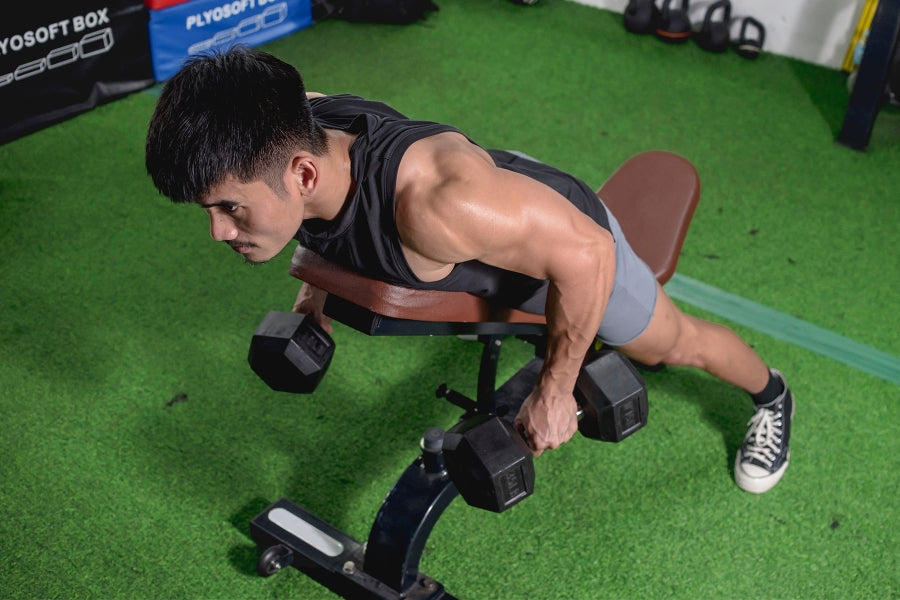
Many traditional exercises like deadlifts and squats place significant pressure on the spine, which may not be ideal for everyone. The chest-supported dumbbell row offers a safer alternative by providing spinal support throughout the movement.
This variation minimizes lower back strain while effectively targeting the upper and mid-back muscles. It enhances posture, improves back strength, and helps build a more balanced physique without compromising safety.
How to Perform Chest Supported Dumbbell Row
- Set a bench at a 45-degree incline and lie face down with your chest and stomach supported.
- Hold a dumbbell in each hand with arms extended straight toward the floor.
- Pull the dumbbells up toward your hips by squeezing your shoulder blades together.
- Pause briefly at the top of the movement for maximum contraction.
- Lower the dumbbells slowly back to the starting position.
- Repeat for the desired number of reps.
Conclusion
In this guide, we’ve explored the versatility and impact of weight bench exercises, showcasing 15 effective movements to target your chest, arms, back, and core.
To perform these exercises safely and effectively, it’s essential to have a high-quality, foldable weight bench and the right accessories. Proper equipment not only enhances performance but also helps prevent injury.
If you're looking for reliable, durable, and performance-tested fitness gear, DMoose offers a wide range of products tailored to support your training goals.
From strength training essentials to advanced workout tools, DMoose is committed to helping you train smarter, safer, and with confidence.








